| Article ID | Journal | Published Year | Pages | File Type |
|---|---|---|---|---|
| 6862101 | Knowledge-Based Systems | 2017 | 21 Pages |
Abstract
Many-objective Optimization Problems (MaOPs) present various challenges to the current optimization methods. Among these, the visualization gap is an important obstacle to the interpretation of results. Having the ability of visualizing partial or final results of a high-dimensional multi-objective problem provides key advantages to the optimizer and also to the decision-maker in terms of understanding the problem and interpreting results. In this article, a multi-purposed visualization tool is proposed to be applied in an evolutionary design process. The proposed visualization tool follows the circular design layout, mapping the solutions from high-dimensional objective space into a 2D form of scattering that is based on norm and angle information. Meanwhile, it preserves some desirable characteristics of objective space, such as the shape of the Pareto front, its location, relations between objectives etc. With the support of this tool the decision-maker can obtain information about the shape of the Pareto front, the range of explored area by the algorithms, qualitative estimation of algorithm performance, relation between objectives, location of solutions and their dispersion. Furthermore, this application has scalability and flexibility about the number of objectives and population size. Finally, the proposed mapping allows the decision-maker to visually identify poorly explored regions of the objective space and determine weight vectors to guide the search to a specific or preferred region. The case studies in the experimental results show that this tool can play a role in the design process and help the evolutionary solving process.
Related Topics
Physical Sciences and Engineering
Computer Science
Artificial Intelligence
Authors
Roozbeh Haghnazar Koochaksaraei, Ivan Reinaldo Meneghini, Vitor Nazário Coelho, Frederico Gadelha Guimarães,
